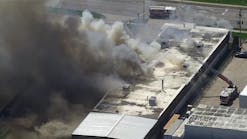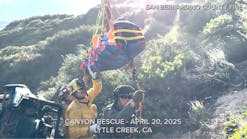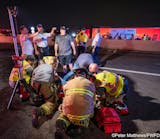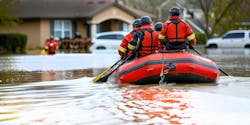If there were a report of a mass shooting in your community, how would your agency respond? Would you immediately enter the "hot zone" or wait blocks away until it is all over?
Five major events in the past few years emphasize the need for fire-EMS departments to address the possibility of mass-shooting events taking place in their communities. Most recently, a gunman killed 32 people and himself at Virginia Tech in Blacksburg, VA, on April 16, 2007. Another incident occurred on March 11, 2005, in Atlanta, GA, where a judge, a sheriff's deputy and a court reporter were shot and killed and another deputy was critically wounded at a courthouse before the gunman fled from the scene and carjacked a motorist.
On March 12, 2005, at a hotel in Brookfield, WI, a shooter opened fire during a church service being held at a hotel, killing at least four people and sending several others to hospitals. The gunman then apparently shot and killed himself. On March 21, 2005, in Red Lake, MN, a high school student killed nine people and injured a dozen more before killing himself. He was wearing stolen body armor during the attack. Yet another attack took place on Jan. 30, 2006, in Goleta, CA, when a woman shot six postal employees to death and committed suicide in what was believed to be the nation's deadliest workplace shooting by a woman. It was the deadliest shooting at any U.S. workplace since 2003, when a man gunned down 14 co-workers, killing six, and then committed suicide at a Lockheed Martin aircraft parts plant in Meridian, MS. It also was the bloodiest rampage at a U.S. Postal Service installation since 1986, when a letter carrier killed 14 people in Edmond, OK, and then took his own life.
Another shooting spree occurred on April 18, 2006, in St. Louis, MO. A man entered a business and shot and killed four women, injured another woman, and then killed himself in a parking lot.
Threat Groups
How would your agency respond to reports of an active shooter or mass shootings? Do you stage six blocks down the road and wait for the scene to be secured, even with downed police officers and civilians? What happens when this event occurs at a church or school? Do you loan fire apparatus or staff to law enforcement agencies for their use during the response and investigations? Fire-EMS departments are an essential part of the response to these incidents and must plan accordingly.
Law enforcement, fire and EMS share some of the same priorities during a mass-shooting incident, so planning and interagency cooperation should be paramount. Several issues must be addressed during the planning phase. Law enforcement will need fire and EMS coverage and equipment (vehicles, ladders, breaching tools, fire extinguishers, trauma packs, etc.) during the incident. EMS may need to provide tactical medics and set up triage areas away from the scene. Law enforcement will need to provide security for fire and EMS units entering the "hot zone." A coordinated effort among all agencies can ensure a safe and effective response.
Does your department have guidelines and procedures for dealing with mass shooting or other violent events? National Fire Protection Association (NFPA) 1500 Standard on Fire Department Occupational Safety and Health Program, 8.7 Civil Unrest/Terrorism, states, "The fire department shall develop and maintain written standard operating procedures that establish a standardized approach to the safety of members at incidents that involve violence, unrest, or civil disturbance (8.7.2). Such situations shall include but not be limited to civil disturbances, fights, violent crimes, drug-related situations, family disturbances, deranged individuals, and people interfering with fire department operations (8.7.2.1). The fire department shall be responsible for developing an interagency agreement with its law enforcement agency counterpart to provide protection for fire department members at situations that involve violence (8.7.3)."
Preparation is the key to a mass-shooting incident and that includes a clear idea of your actions before the incident occurs. The first step in your preparation is a review of your agency's guidelines and procedures when responding to a mass shooting. Another important step is to bring all the key agencies together such as law enforcement, fire, EMS, emergency management, hospitals and the school system to discuss this type of event. Every jurisdiction, big or small, should have a Local Emergency Planning Committee (LEPC) or Terrorism Task Force (TTF) to discuss this issue. As with any multi-hazard assessment and planning process, it is wise to conduct a multi-agency exercise (tabletop or functional) to bring all the key agencies together and rehearse the plan once it has been completed.
Safety & Security
When planning to respond to mass shootings, it is important to consider the information that will be released to the public. It is critical for public safety agencies and special operations teams involved in planning and training for mass-shooting and active-shooter events to use Operations Security (OPSEC) in their planning and training efforts. OPSEC is a five-step risk-management process used by military and security professionals to protect sensitive information that adversaries could use.
Critical information on planning and training must be protected. Criminals can take weeks and months to select their targets and plan their operations. To be successful, they need specific information about personnel, response plans, capabilities and infrastructures. It is important that the responders involved in planning and training for critical events identify and treat their critical information as sensitive so that it does not end up in the hands of the "bad guys." (See "Think Like the Wolf," Firehouse, April 2006.)
The National Institute for Occupational Safety and Health (NIOSH) Fire Fighter Fatality Investigation and Prevention Program conducts investigations of firefighter line-of-duty deaths to formulate recommendations for preventing future deaths and injuries. For additional information on the program see www.cdc.gov/niosh/firehome.html.
NIOSH has released report FACE-F2004-11 which listed the following recommendations for fire departments involved in the responding to scenes of violence:
- Develop standard operating procedures (SOPs) for responding to potentially violent situations.
- Develop integrated emergency communication systems that include the ability to directly relay real-time information between the caller, dispatch, and all responding emergency personnel.
- Provide body armor or bullet-resistant personal protective equipment, and train on and consistently enforce its use when responding to potentially violent situations.
- Ensure all emergency response personnel have the capability for continuous radio contact and consider providing portable communication equipment that has integrated hands-free capabilities.
- Consider requiring emergency dispatch centers to incorporate the ability to archive location, or individual, historical data and provide pertinent information to responding fire and emergency medical services personnel.
- Develop coordinated response guidelines for violent situations and hold joint training sessions with law enforcement, mutual aid and emergency response departments.
Lessons Learned
It is important that we take the valuable - and sometimes fatal - lessons learned from past incidents and apply them to future training and planning. Fire and EMS responders will encounter many challenges during their careers, including acts of violence involving weapons. Experience with mass-shooting incidents has shown that:
Pre-planning is critical.
First-arriving units have a drastic effect on the progress of the incident. They must quickly and safely conduct "windshield surveys."
Immediate interagency cooperation and unified command are essential.
Clear communications are necessary for effective operations.
Access to helicopters for overhead assessments is a plus.
All key agencies and supporting entities such as emergency management officials and hospitals should be notified as quickly as possible.
A large and immediate media response should be expected.
Parents, family and friends will converge on the scene.
Fire and EMS personnel should wear helmets and clearly marked clothing.
Body armor should be obtained for those responding into the "impact" area.
Related and unrelated 911 call volume may increase.
EMS may need to implement disaster procedures such as triage tags, casualty collection points and field treatment areas for minor injuries.
Use of tactical medics in supporting law enforcement operations is encouraged.
Shooters may use secondary devices.
Special Response Teams
If there is a law enforcement Special Response Team (SRT) or Special Weapons and Tactics (SWAT) unit in your jurisdiction, ask for its assistance. Most if not all-special response teams have trained for an active-shooter event.
There are several excellent sources of information to utilize when planning and training:
When Violence Erupts: Survival Guide for Emergency Responders by Dennis Krebs, www.medicsurvival.com
Understanding Terrorism and Managing The Consequences, Chapter 3 - Terrorism/Tactical Violence Incident Response Procedures, by Paul M. Maniscalco and Hank T. Christen, www.bradybooks.com.
Another tool to assist in the planning phase is the "Wanton Violence at Columbine High School Technical Report" available from the Federal Emergency Management Agency (FEMA) at www.fema.gov for public safety agencies. This is an in-depth analysis of fire and EMS operations and the overall response to the assault on Columbine High School at Littleton, CO, on April 20, 1999.
Conclusion
Law enforcement officers receive "active-shooter response" training as part of their basic schooling. Fire and EMS departments and other emergency response agencies should gain at least an awareness-level understanding of mass-shooting events and the threats they present.
Each community should have a plan in place to address mass-shooting incidents. The more our public safety agencies plan, the better prepared they are to respond and effectively manage any type of situation that may arise.
AUGUST VERNON is an assistant coordinator with the Forsyth County, NC, Office of Emergency Management. He recently returned from a year in Iraq as a security contractor. Vernon is also an adjunct instructor for the "OPSEC for Public Safety" Program. He has been involved in emergency management since 2000 and a member of the fire service since 1990. Vernon also served in the U.S. Army as an NBC (Nuclear, Biological and Chemical) Operations Specialist. He is involved in teaching Incident Management and terrorism/WMD related subjects and can be reached reference for questions or comments at fdtac@yahoo.com.





